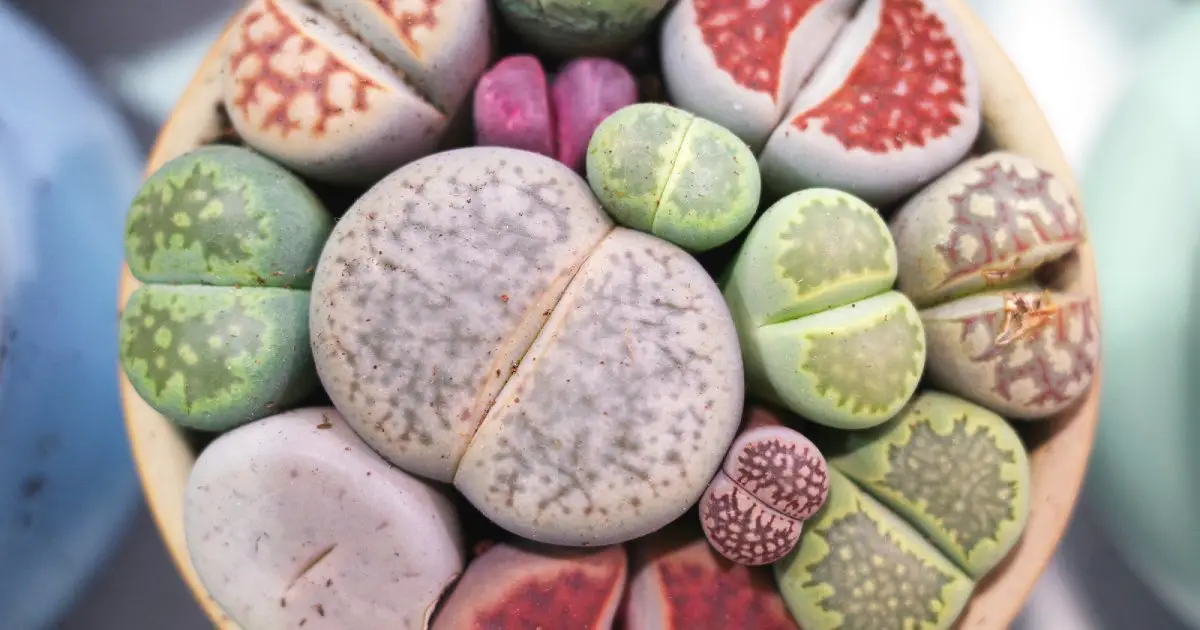Living stones (Lithops) are tiny yet attention-grabbing succulents that look like rocks, and their maintenance needs are only slightly more burdensome than those of the classic Pet Rock. That means Lithops are a perfect resilient plant for forgetful plant owners, no 32-page care manual is required!
If you’re looking for an adorable houseplant that thrives on neglect, look no further than Living Stones.
Quick Guide to Lithops
| Sun requirements | Prefer full sun, will tolerate some shade |
| Hardiness/Zone | Hardy in zones 10-11 |
| Water needs | Extremely minimal, no water at all in the winter |
| Toxicity | Non-toxic |
| Primary growth season | Growth in summer, dormant from fall to spring |
| Typical size at maturity | Only 1 inch tall and 1-3 inches wide (two leaves with essentially no stem) |
Living Stones’ Physical Appearance
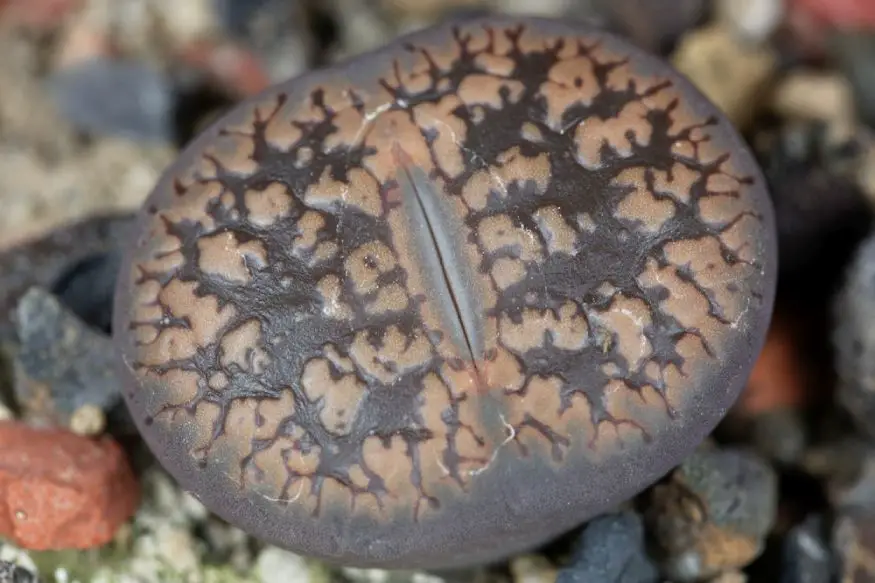
There are 37+ species and 145+ varieties of living stones, which come in a variety of colors and patterns, but all have virtually the same growth patterns and care needs. The color range includes red green purple, grey, pink, and other shades, either uniformly or with mottled, veined, dotted, or other markings.
These plants are all structurally similar. They grow two leaves joined at a groove, so that from above they resemble the imprint in the soil from the footstep of a cloven-hoofed animal. They are virtually stemless, the two leaves growing flush with the ground and never getting any taller.
In drought, the visible leaves of living stones may die off, leaving only the roots below the soil, which will stay dormant until the next rainfall. The leaves also die back in the fall, when the plant is about to produce its new leaves.
Many living stones flower in the late fall or early winter, with a single blossom emerging from the crevice between the two leaves. Some are even scented.
Note: After flowering the plant produces a pair of new leaves from the groove between the leaves. The older leaves will dry up and die. At that point, the plant begins its winter dormancy.
Growing Requirements for Lithops
Outdoor Placement
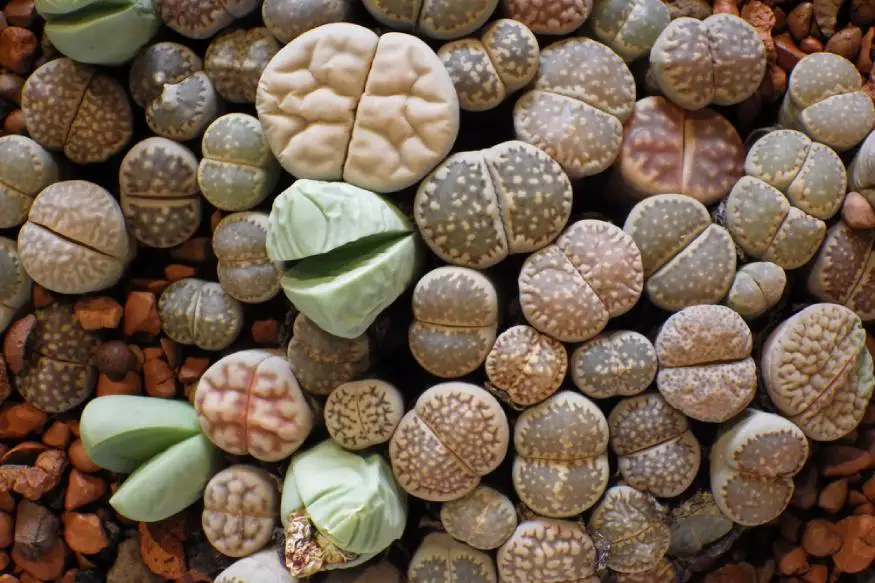
Living stones originate in arid regions in southern Africa. This means they are accustomed to extremes. They prefer high heat, lots of sun, and almost no water. Because they are so small and, therefore have fairly shallow roots, and they are accustomed to deserts with rocky and sandy soil, they are a perfect choice for rock gardens or other areas with “poor” soil.
Because they are so drought-tolerant and typically require no water at all during their winter dormancy, they may not survive in a climate that gets much rainfall during the winter, especially if they are planted in soil rich in organic matter, which retains water.
Note: Unless you live in a place with rather dry winters, planting your living stones in a pot that can be moved to a dry spot for winter may be a better option than planting them in the ground.
Indoor Placement

While they do great in the desert or greenhouse temperatures, lithops can be grown inside your home if you keep the temperature in the mid-sixties or higher. You’ll want to place your lithops in your sunniest windowsill, ensuring they get at least five hours of sunlight each day.
Pet Access
Lithops are nontoxic and safe to grow in households with small children and pets. For more suggestions for safe houseplants, check out our round-up of pet-safe succulents.
Living Stone Plants Container and Soil
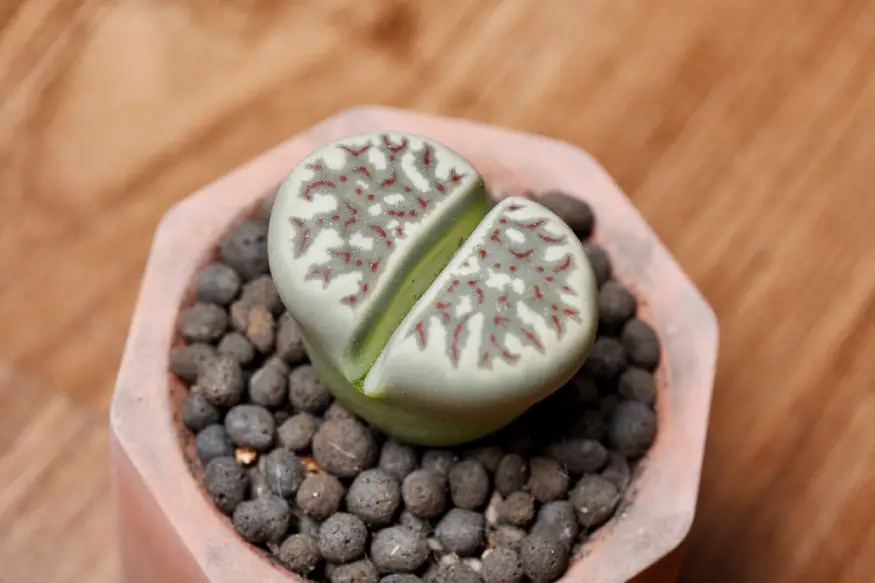
Although most of the plant is underground, Lithops are such small plants that they have fairly shallow roots, so potting them in a shallow planter is important. Just a few inches of potting mix is plenty. This is especially important for Lithops, even more than most succulents, because they are so drought-adapted.
Note: A pot that is too large and contains too much potting mix will take too long to dry out, which can cause your Lithops to rot.
If you have a typically-proportioned pot you want to use, you can try using our “pot in a pot” method. To do so, you would need to find a shallow plastic pot with nearly the same diameter as the decorative pot you want to use. Plant your living stones in the plastic pot, and then nest it inside the decorative pot.
You can put rocks inside the decorative pot to rest the plastic pot on. However, if your decorative pot doesn’t have a drainage hole, remove the plastic pot before watering and let it drain before returning it to the decorative pot. This way, the water doesn’t accumulate in the bottom of the decorative pot.
Note: The excess humidity from the water sitting in the bottom of the pot, slowly evaporating, can kill your living stones.
Commercially available cactus/succulent-specific potting mixes will work okay for Lithops, but making your own potting mix is much better for your plant as well as cheaper.
We recommend a different ratio of ingredients for living stones than most succulents (with less organic matter) because they thrive in poor, rocky soil. You don’t have to be strict about the ratios, but for Lithops we recommend:
- One part potting soil, ideally a cactus blend,
- One or two parts coarse sand, and
- Two parts: gritty amendment (such as perlite, pumice, or gravel).
Giving a plant so little organic matter may seem strange, but imitating a plant’s natural environment is the best way to keep your succulent happy and healthy.
Watering The Living Stone Plant
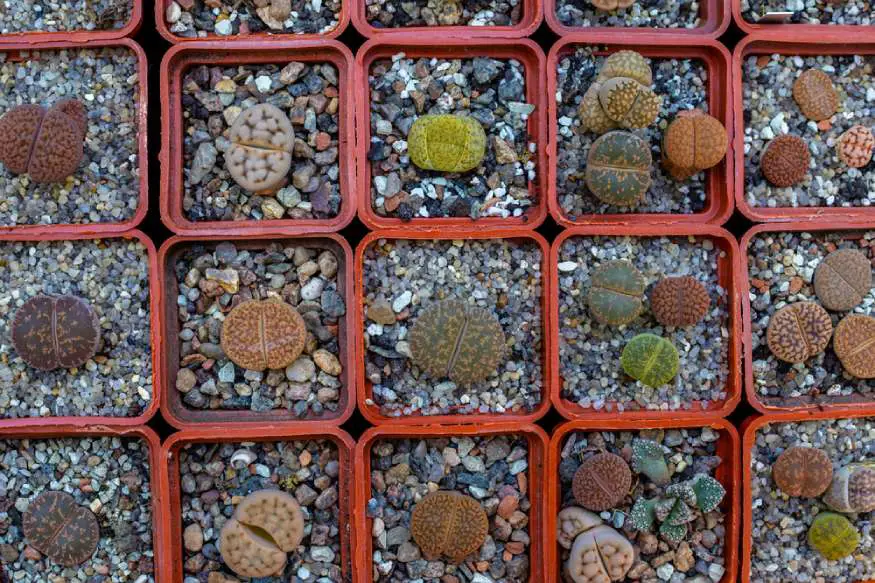
Originating in South African deserts means that Lithops’ capacity for handling drought is extraordinary, almost supernatural. The average annual rainfall where most Lithops species live is less than 20 inches, while some species survive on less than four inches, and a few rely exclusively on fog as their source of moisture. Virtually the entire body of the plant is devoted to water storage.
In that context, it should be no surprise that living stones have extremely minimal watering needs. Outdoors, you are likely to find that they do not require any water at all to supplement the natural rainfall. Indoors, as you would expect, the biggest problem most lithops face is overwatering.
Note: Typically indoor lithops go dormant from the late fall to early spring. Outdoors, they may also go dormant in the summer. They require little to no water during their dormant period(s).
After the new leaves begin growing in the fall, we recommend not watering until spring. Watering too late into the fall can kill your living stones because that is when the old leaves should dry up and die, which allows the new leaves to grow. Only water during the winter if the new leaves are also shriveled.
During the living stones’ growing seasons, we recommend watering only as needed, using the “soak and dry” method.
Note: Because your living stones may need watering only a few times a year, it’s a good idea to keep track so that you don’t forget entirely.
Fertilizer and Maintenance

Lithops are accustomed to poor, rocky soil, so they don’t need a lot of fertilizing. If you re-pot your living stones when you bring them home, don’t bother fertilizing the first year, as the fresh soil will have plenty of nutrients. In subsequent years, fertilizing once, at the beginning of the spring growing season, is plenty.
When you do feed your living stones, use a liquid fertilizer, preferably organic. If you are using a chemical liquid fertilizer meant for houseplants but not succulents specifically, dilute to at most half-strength (quarter-strength is best).
As with all succulents, you want to avoid any imbalanced fertilizer, in the sense that it has a higher proportion of nitrogen than the other elements. Living stones have minimal leaf growth, so they need more potassium than nitrogen.
If you’re using an organic fertilizer formulated specifically for cacti or succulents, follow the package instructions regarding any necessary dilution. For more information, check out our comprehensive guide to fertilizing succulents.
Note: Lithops don’t typically need any maintenance other than watering and fertilizing. You can remove the dry husks of the old leaves in the spring if they haven’t fallen off on their own.
Propagation
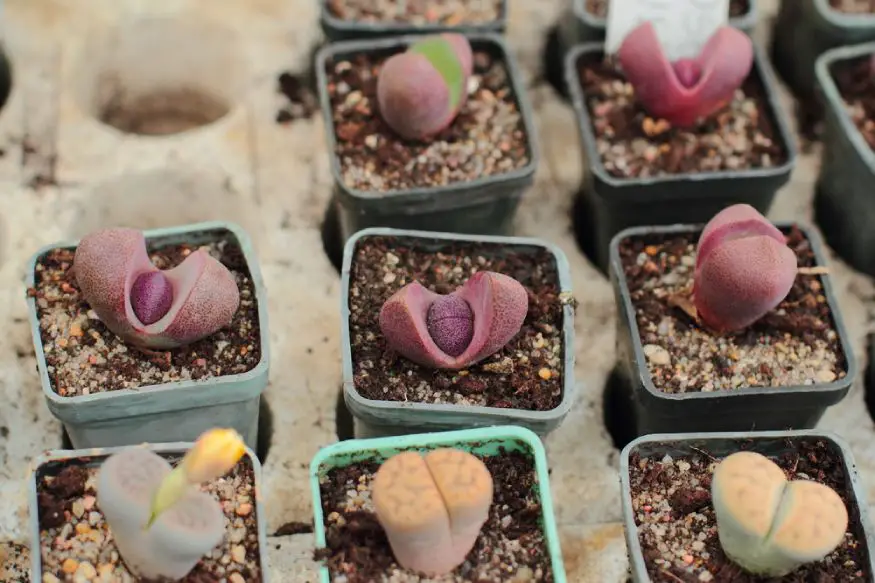
Lithops are not as easy to propagate as other succulents. They don’t produce offsets and don’t have stems or leaves that can be easily propagated. There are two ways to grow new living stones.
One option is to grow them from seed. However, this is a laborious process — they may take a year to sprout.
You can generate your own seeds if you have multiple living stone plants. In nature, living stones require rainfall-assisted cross-pollination to reproduce, they cannot self-pollinate, so if you want seeds, you’ll have to help.
Note: After they flower, you can use a cotton swab to transfer pollen from the flower on one plant to the other. Then, harvest the seed pods that form.
Occasionally, when living stones dry out and die back in the fall, allowing the new leaves to grow from the groove in the center, you will have an opportunity for propagation.
Sometimes, instead of only growing one new pair of leaves, like normal, healthy, mature Lithops will multiply independently. In other words, they will produce two pairs of leaves instead of one. You can divide these to grow two new plants.
To divide your multi-headed Lithops, first remove it from the soil. Use a sharp, sterile knife to divide the two pairs of leaves, ensuring each plant has attached roots. Allow them to cure, then replant. Check out our propagation guide for more detailed tips and techniques.
Common Living Stones Problems
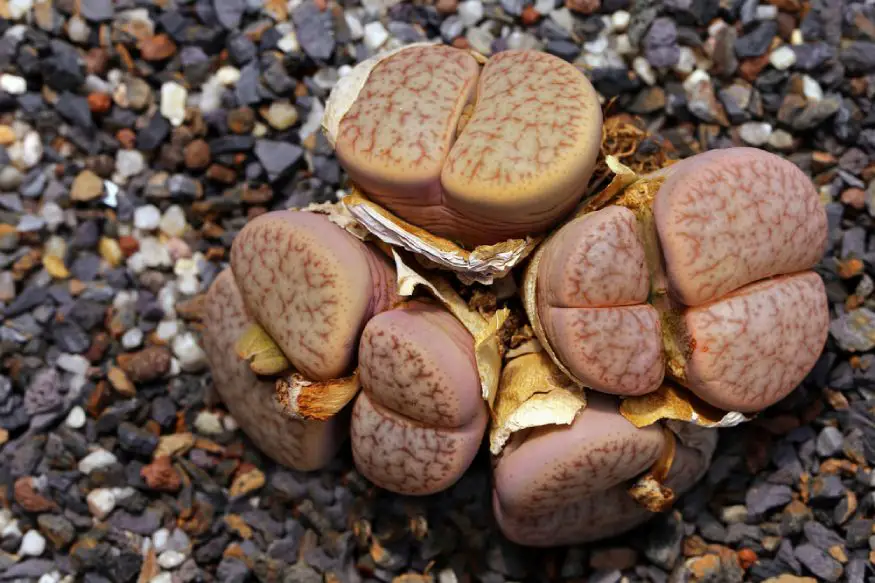
Like most succulents, living stones are pretty bomb-proof. There isn’t much to worry about as long as you meet their basic needs. However, there are a few things to keep an eye out for to ensure your plant stays healthy.
- Wilting, mushy, discolored leaves: You are overwatering your plant. Remember, it will probably only need watering a few times each year.
- Stretching: Living stones have no stem; the leaves rest directly on the soil. If you notice that your plant has grown a little leggy, that is a good indication that your plant is getting inadequate sunlight.
- Scale: Living stones don’t have all the little nooks and crannies common to most succulents, which means they’re much less susceptible to being infested by the little critters that like to hide in them. However, it could be scale if you notice flat, brown, immobile spots on your living stones.
- Brown patches on leaves: While living stones love a lot of sunlight, they need to be transitioned gradually if you move them from more limited to lots of direct sunlight. Making the transition too quickly can cause sunburn.
- Leaves are dying (brown, dry, and crispy): Is it autumn? If so, this is part of these plants’ natural life cycle.The old leaves have to dry and die off for the new leaves to develop. Ignore it. If the leaves are drying out during other times of year, it probably needs water.
If your succulent is having these issues or any others, check out our guide to diagnosing and fixing problems with your ailing succulents.
Being a Good Plant Parent to Your Living Stones
Even better than a pet rock, living stones make a wonderful companion. They don’t bark at night, pee on the floor, or need food and water daily. All you have to do is give them a warm, sunny windowsill and water far less frequently than you think you need to. Living stones are truly the ideal pets for forgetful owners.

